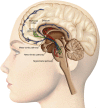Orquestic regulation of neurotransmitters on reward-seeking behavior
- PMID: 25061480
- PMCID: PMC4108978
- DOI: 10.1186/1755-7682-7-29
Orquestic regulation of neurotransmitters on reward-seeking behavior
Abstract
The ventral tegmental area is strongly associated with the reward system. Dopamine is released in areas such as the nucleus accumbens and prefrontal cortex as a result of rewarding experiences such as food, sex, and neutral stimuli that become associated with them. Electrical stimulation of the ventral tegmental area or its output pathways can itself serve as a potent reward. Different drugs that increase dopamine levels are intrinsically rewarding. Although the dopaminergic system represent the cornerstone of the reward system, other neurotransmitters such as endogenous opioids, glutamate, γ-Aminobutyric acid, acetylcholine, serotonin, adenosine, endocannabinoids, orexins, galanin and histamine all affect this mesolimbic dopaminergic system. Consequently, genetic variations of neurotransmission are thought influence reward processing that in turn may affect distinctive social behavior and susceptibility to addiction. Here, we discuss current evidence on the orquestic regulation of different neurotranmitters on reward-seeking behavior and its potential effect on drug addiction.
Keywords: Dopamine; Drug addiction; Endocannabinoids; Galanin; Histamine; Orexin; Reward-seeking behavior; Serotonin.
Figures


Similar articles
-
Reward-seeking behavior and addiction: cause or cog?Curr Drug Abuse Rev. 2012 Sep;5(3):178-89. doi: 10.2174/1874473711205030178. Curr Drug Abuse Rev. 2012. PMID: 22571449 Review.
-
Ventral Tegmental Area Dopamine Cell Activation during Male Rat Sexual Behavior Regulates Neuroplasticity and d-Amphetamine Cross-Sensitization following Sex Abstinence.J Neurosci. 2016 Sep 21;36(38):9949-61. doi: 10.1523/JNEUROSCI.0937-16.2016. J Neurosci. 2016. PMID: 27656032 Free PMC article.
-
Dopamine and glutamate release in the nucleus accumbens and ventral tegmental area of rat following lateral hypothalamic self-stimulation.Neuroscience. 2001;107(4):629-39. doi: 10.1016/s0306-4522(01)00379-7. Neuroscience. 2001. PMID: 11720786
-
Neuropharmacological mechanisms of drug reward: beyond dopamine in the nucleus accumbens.Crit Rev Neurobiol. 1998;12(1-2):37-67. doi: 10.1615/critrevneurobiol.v12.i1-2.30. Crit Rev Neurobiol. 1998. PMID: 9444481 Review.
-
Activation of Pedunculopontine Glutamate Neurons Is Reinforcing.J Neurosci. 2017 Jan 4;37(1):38-46. doi: 10.1523/JNEUROSCI.3082-16.2016. J Neurosci. 2017. PMID: 28053028 Free PMC article.
Cited by
-
Increasing the Reinforcing Value of Exercise in Overweight Adults.Front Behav Neurosci. 2019 Dec 3;13:265. doi: 10.3389/fnbeh.2019.00265. eCollection 2019. Front Behav Neurosci. 2019. PMID: 31849625 Free PMC article.
-
Transcriptome Analysis of NPFR Neurons Reveals a Connection Between Proteome Diversity and Social Behavior.Front Behav Neurosci. 2021 Mar 31;15:628662. doi: 10.3389/fnbeh.2021.628662. eCollection 2021. Front Behav Neurosci. 2021. PMID: 33867948 Free PMC article.
-
Unveiling the Mystery of the Stimulatory Effects of Arecoline: Its Relevance to the Regulation of Neurotransmitters and the Microecosystem in Multi-Ecological Intestinal Sites.Int J Mol Sci. 2025 Mar 28;26(7):3150. doi: 10.3390/ijms26073150. Int J Mol Sci. 2025. PMID: 40243919 Free PMC article.
-
Volume Gain of Brainstem on Medication-Overuse Headache Using Voxel-Based Morphometry.Chin Med J (Engl). 2018 Sep 20;131(18):2158-2163. doi: 10.4103/0366-6999.240807. Chin Med J (Engl). 2018. PMID: 30203789 Free PMC article.
-
Activating SIRT-1 Signalling with the Mitochondrial-CoQ10 Activator Solanesol Improves Neurobehavioral and Neurochemical Defects in Ouabain-Induced Experimental Model of Bipolar Disorder.Pharmaceuticals (Basel). 2022 Aug 2;15(8):959. doi: 10.3390/ph15080959. Pharmaceuticals (Basel). 2022. PMID: 36015107 Free PMC article.
References
-
- Pagnoni G, Zink CF, Montague PR, Berns GS. Activity in human ventral striatum locked to errors of reward prediction. Nat Neurosci. 2002;5(2):97–98. - PubMed
-
- Shizgal P. Neural basis of utility estimation. Curr Opin Neurobiol. 1997;7(2):198–208. - PubMed
-
- Carelli RM. Nucleus accumbens cell firing during goal-directed behaviors for cocaine vs. ‘natural’ reinforcement. Physiol Behav. 2002;76(3):379–387. - PubMed
Publication types
LinkOut - more resources
Full Text Sources
Other Literature Sources
